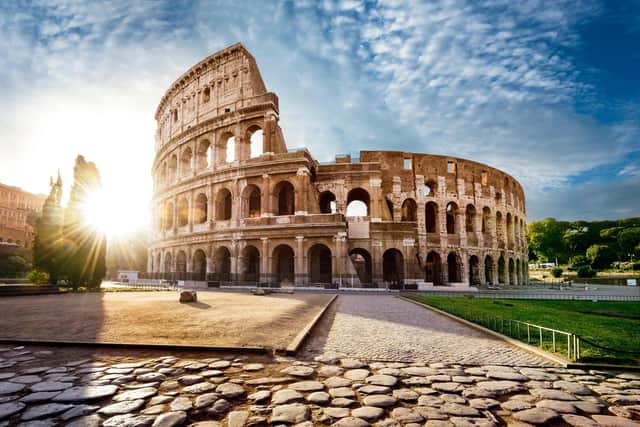Secret to durability of Roman concrete that has stood test of time for over 2,000 years finally unearthed
And they have isolated the ingredient that allows Roman concrete to self-heal, making it stronger than its modern equivalent.
Scientists say their "back to the future" findings could help reduce the environmental impact of cement production.
Advertisement
Hide AdAdvertisement
Hide AdThe ancient Romans were early masters of engineering – building huge networks of roads, aqueducts, ports and temples whose remains have survived for two millennia.


Many of the structures were built with concrete including Rome's Pantheon, which has the world's largest unreinforced concrete dome and is still intact despite being dedicated in the year 128 AD.
Some ancient Roman aqueducts still deliver water to the Eternal City today, while many modern concrete structures crumble after just a few decades.
Scientists have spent decades trying to figure out the secret of the "ultradurable" construction material, particularly in structures that endured especially harsh conditions, such as docks, sewers, and seawalls.
Now an international team has discovered ancient concrete-manufacturing techniques that incorporated several key "self-healing" properties.
For many years, researchers have assumed the key to the ancient concrete's durability was based on one ingredient – pozzolanic material such as volcanic ash from the area of Pozzuoli, on the Bay of Naples.
That specific kind of ash was even shipped all across the vast Roman empire to be used in construction, and was described as a key ingredient for concrete in accounts by architects and historians at the time.
Under closer examination, these ancient samples also contain small, distinctive, millimetre-scale bright white mineral features, which have been long recognised as a ubiquitous component of Roman concretes.
Advertisement
Hide AdAdvertisement
Hide AdThe white chunks – often referred to as "lime clasts" – originate from lime, another key component of the ancient concrete mix.
Study leader Admir Masic, a professor of civil and environmental engineering at Massachusetts Institute of Technology, said: "Ever since I first began working with ancient Roman concrete, I've always been fascinated by these features. These are not found in modern concrete formulations, so why are they present in these ancient materials?"
Previously disregarded as merely evidence of sloppy mixing practices, or poor-quality raw materials, the new study suggests the tiny lime clasts gave the concrete a previously unrecognised self-healing capability.
Prof Masic said: "The idea that the presence of these lime clasts was simply attributed to low-quality control always bothered me. If the Romans put so much effort into making an outstanding construction material, following all of the detailed recipes that had been optimised over the course of many centuries, why would they put so little effort into ensuring the production of a well-mixed final product? There has to be more to this story."
Using high-resolution multiscale imaging and chemical mapping techniques pioneered in Prof Masic's lab, the researchers gained new insights into the lime clasts.
Historically, it had been assumed that when lime was incorporated into Roman concrete, it was first combined with water to form a highly reactive paste-like material, in a process known as slaking.
But Prof Masic said the process alone could not account for the presence of the lime clasts.
He wondered if it was possible the Romans might have actually directly used lime in its more reactive form, known as quicklime.
Advertisement
Hide AdAdvertisement
Hide AdStudying samples of the ancient concrete, he and his team determined the white inclusions were made out of various forms of calcium carbonate.
Further analysis provided clues they had been formed at extreme temperatures, as would be expected from the exothermic reaction produced by using quicklime instead of, or in addition to, the slaked lime in the mixture.
The research team has now concluded that "hot mixing" was actually the key to the concrete's super-durable nature.
Prof Masic said: "The benefits of hot mixing are two-fold. First, when the overall concrete is heated to high temperatures, it allows chemistries that are not possible if you only used slaked lime, producing high-temperature-associated compounds that would not otherwise form.
"Second, this increased temperature significantly reduces curing and setting times since all the reactions are accelerated, allowing for much faster construction."
He said that, during the hot mixing process, the lime clasts develop a characteristically brittle nanoparticulate architecture, creating an easily fractured and reactive calcium source, which, as the team proposed, could provide a "critical" self-healing functionality.
The researchers produced samples of hot-mixed concrete that incorporated both ancient and modern formulations, deliberately cracked them, and then ran water through the cracks.
Prof Masic said that within two weeks the cracks had completely healed and the water could no longer flow.
Advertisement
Hide AdAdvertisement
Hide AdHe hopes the team's findings, published in the journal Science Advances, could help reduce the environmental impact of cement production, which currently accounts for about eight per cent of global greenhouse gas emissions ENDS
Comments
Want to join the conversation? Please or to comment on this article.